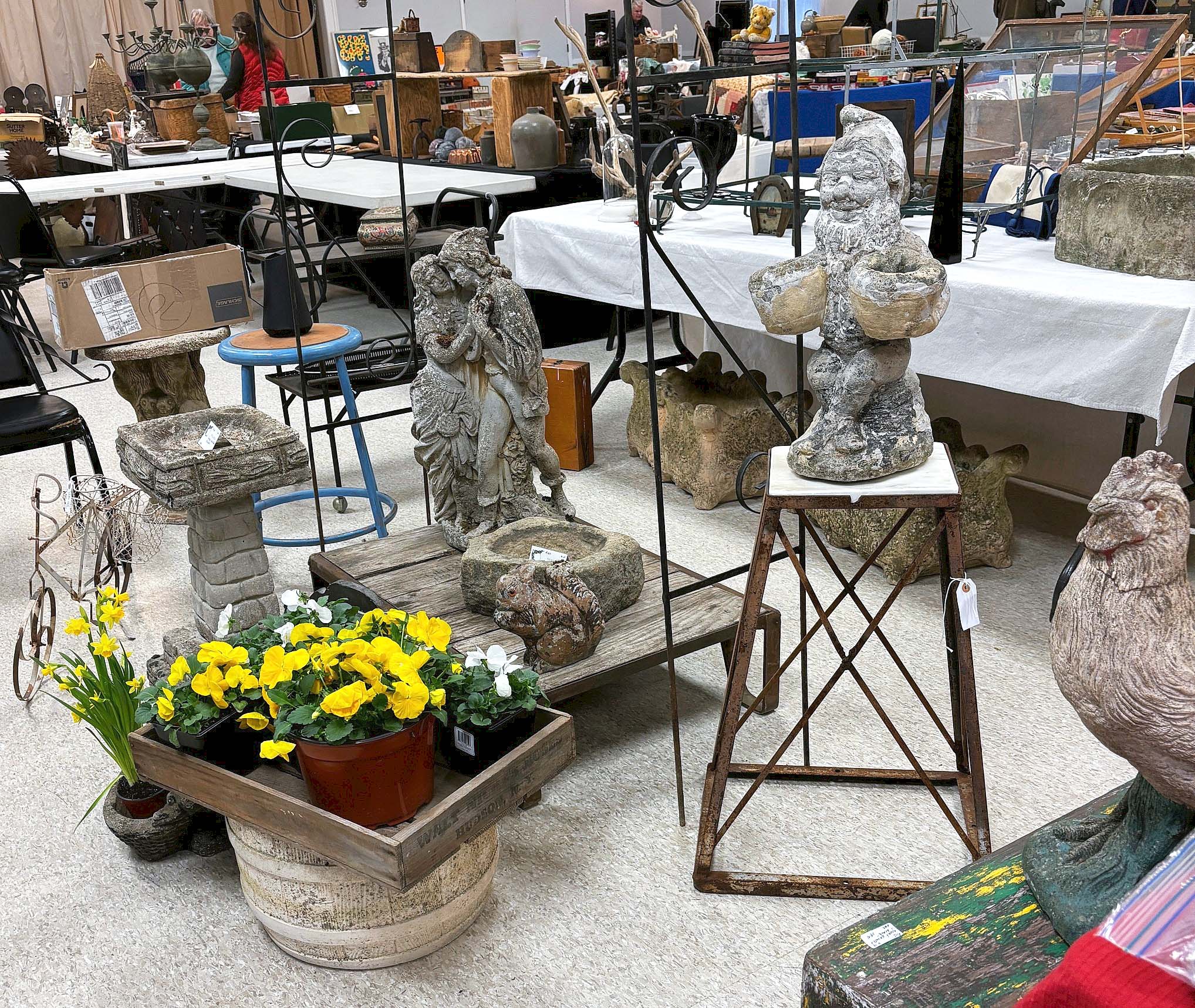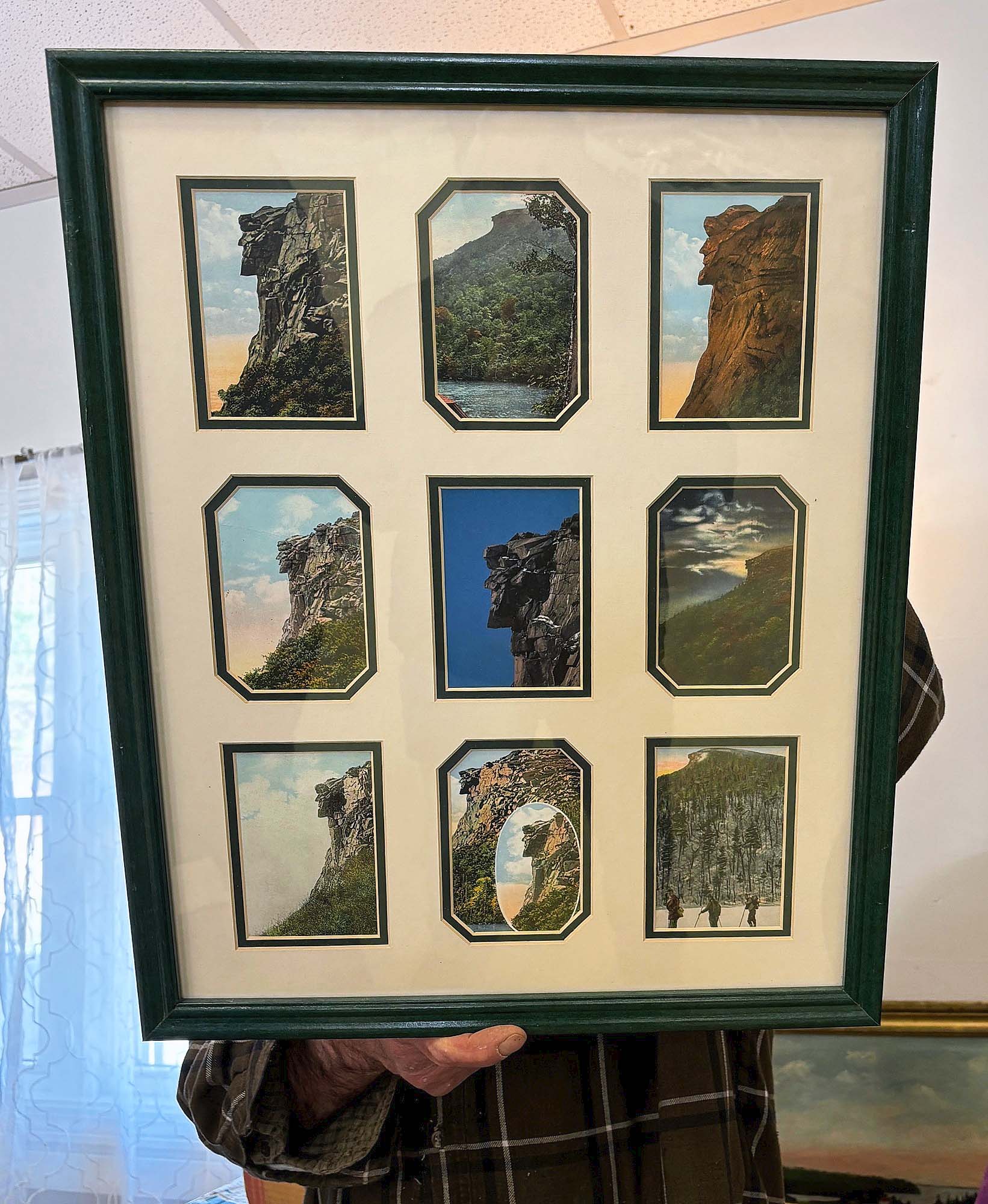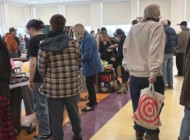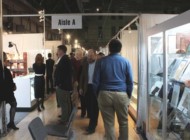
A wide selection of vintage cast stone garden fixtures were in the booth of Sugarplum Antiques, Wilmot, N.H. The gnome on the right was marked $60, the bird bath on the left $145.
Review & Onsite Photos by Rick Russack
DOVER, N.H. — The Dover Elks Lodge has hosted an antiques show for decades, though it was called the Dover Flea Market when the brother-sister team of Josh and Rachel Gurley bought it from Deb Hayes eight years ago They have slowly expanded its coverage and now call it the Dover Antique Flea Market. The series begins in late October and continues indoors at the Dover Elks Lodge on the first Wednesday of each month; the season’s finale took place on April 3. Note this is a separate show from the one the Gurleys created in 2020 because of the pandemic. Called the Dover Antique Show & Vintage Market, that show runs monthly on Saturdays beginning on May 18 and offers vendors both indoor and outdoor booths.
The April 3 season finale had about 35 dealers. Some had cancelled due to ominous weather forecasts, but the spring Nor’easter arrived later than originally forecasted and actually did not impact the show. To call the show a flea market is a misnomer. Exhibitors included some who do the New Hampshire Antiques Dealers show in August and one who participates in antiquarian book fairs produced by the Antiquarian Booksellers’ Association of America (ABAA). And some exhibitors are regulars at other Gurley shows. The result is an assortment of merchandise, with booths full of surprises. Rachel Gurley termed it “Our best kept secret,” referring to the quality of the offerings. It’s an easy show for exhibitors: it opens at 8 am and ends at noon. Booth rentals are less than $100. The admission fee for buyers is $5 for the first hour and then its free for the rest of the event.

This cribbage board, in the form of a guitar, looked like something Elvis might have owned. It belonged to Sandy Jacobs, Scott Bassoff-Sandy Jacobs Antiques, Swampscott, Mass. Its history of ownership has been lost to time but it was only $55.
Sandy Jacobs, Scott Bassoff-Sandy Jacobs Antiques, Swampscott, Mass., was doing the show for the first time. Commenting on her range of offerings, she said, “Let’s call it ‘spring cleanout.’ I don’t care what I paid for it; I just have to make some room.” She quickly sold a print of Joyce Wetherbee, an English champion golfer who won numerous titles in the 1920s and who golf icon Bobby Jones referred to “as the best golfer of either sex I’ve ever played.” The print was framed in a hand-carved frame, replete with golf motifs-several clubs, hat, golf bag, tees, a carved likeness of a golfer about to putt and more. The frame was dated 1932 and it’s likely that it will next appear at one of the August New Hampshire shows. Jacobs also had a guitar that looked like Elvis might have used it, decorated with rhinestones and foil. Although it didn’t look like one, it also served as a cribbage board. The price? Just $55. She also brought an arrow weathervane, priced at $250 and a selection of miniature watercolors.
As is often the case, the earliest piece of furniture at the show was in the booth of Benting and Jarvis, Barrington, N.H. The English oak table, circa 1675, had one drawer with a medial runner that Al Benting said helped to date it; he was asking $1,150. He had a selection of early lighting, a small collection of copper lustre and an early, probably Seventeenth Century, hand forged halberd on a long wooden pike.

A table full of cigarette lighters started a conversation with Matthew Taylor, Portland, Maine. Nearly all were made by Zippo and he was asking between $10 and $500 for them.
One of the enjoyable aspects of attending antiques shows is that you often meet a dealer who is passionate about what he or she sells and is more than willing to explain his or her collection. Such was the case with a large assortment of Zippo lighters neatly displayed in the booth of Mathew Taylor, Portland, Maine. When asked the price range of his lighters, he said, “They run from about $10-$500.” What makes a Zippo lighter worth $500? He took one from his display and said, “It’s early. The hinge holding the flip-top to the body of the lighter has three lugs instead of five as later ones do, and it has a patent date on the bottom. Later ones didn’t. And the insert (with the actual lighter) is removable. Those are some of the things a Zippo collector would look for. Many have automotive advertising, or other kinds of advertising and those have cross-over appeal. There are also some with military insignia, or for battles of the Korean and Vietnam wars. Those also have crossover interest. I buy almost anything Zippo made: watches, knives and other things.”
Taylor also had a collection of watches, mostly by Seiko but one was a Tudor, for which he was asking $4,000. He added, “They’re made by Rolex, look like a Rolex, have the Rolex name and some guys call them ‘baby Rolexes.’”
Garden ornaments were in several booths. A selection of well-weathered, vintage English cast stone pieces was offered by Sugarplum Antiques, Wilmot, N.H. Several examples for sale included a tall birdbath that was priced $145, a large planter was $225 and a carved Romeo and Juliet statue, about 3 feet tall, was $295.

Bob Foley had a collection of framed postcards, all of the Old Man of The Mountain in Franconia Notch, N.H. Each of the dozen frames was priced at $50, and included nine postcards.
Bob Foley, Gray, Maine, had a detailed, decorative cast stone lobster for which he was asking $265.
The day after the show, Rachel Gurley said, “I don’t think the weather forecast hurt us. We had the same number of buyers in the first hour that we usually have. Actually, there were a few more. We schedule the show to open at 8 so people can get there before they have to get to work or open their own shops. Buyers were coming in steadily and taking their time checking out what was there. It ended long before the weather got lousy, so everyone was able to get home safely. I didn’t hear any grumbling from buyers or sellers. Twenty years ago, our mom, Nan Gurley, ran a show on Wednesdays. She called it ‘Short and Sweet.’ It was directed towards dealers. This show is similar to that one. Hers worked and so does this one.”
For additional information, call Josh at 207-229-0403 or Rachel at 207-396-4255. For information, www.gurleyantiqueshows.com




















